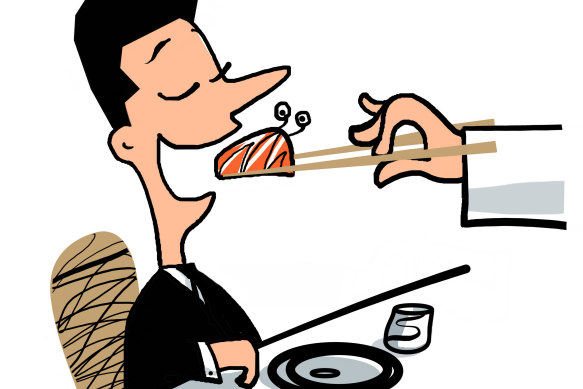This was published 2 years ago
Opinion
The Omakase experience becomes (slightly) more accessible
Terry Durack
Chief restaurant critic for The Sydney Morning HeraldOmakase is not to be confused with OsmoLax. One is a refined Japanese banquet in which the chef will serve you a series of small, handmade dishes that showcase technique, skill, talent, texture, imagination, freshness and seasonality. The other is a product that relieves constipation by … never mind, let’s just stay with omakase.

Credit: Drew Aitken
The most charming definition of omakase is, “I will respectfully leave it to you to decide what’s best”, which also means leaving your preconceptions and habitual orders at the door as if they were shoes at a temple.
In truth, a great omakase joint is similar to a place of worship. You sit at an altar (counter) in celebration (of good food), and you have to pay a tithe of 10 per cent of your income. Or thereabouts. It’s not a cheap night.
For a dining movement in which only eight to 12 guests are served at a time, omakase is one of the biggest trends we’ve seen in Australian dining in a decade, with the precious seats often booked six months in advance.
In truth, a great omakase joint is similar to a place of worship.
I always felt omakase was a club to which I could never belong, its secret rituals as mysterious as Masonic handshakes. Ironically, however, with more omakase restaurants springing up to meet demand, the experience is becoming more accessible.
Some experiences are formal and serene, like Minamishima in Melbourne’s Richmond. Others are tiny diners like Kisuke in Sydney’s Potts Point and Hideaki Fukada’s Kuon in Darling Square. Chase Kojima’s Senpai in Chatswood specialises in ramen amid music and neon, while specialist tempura omakase is on the rise at Tempura Hajime in South Melbourne and Haco in Surry Hills.
One of the most ambitious is Yoshii’s Omakase, an exclusive, 10-seat counter in a corner of Barangaroo’s Nobu overseen by veteran sushi chef Ryuichi Yoshii. For $350 per person, the 16 courses might include lobster wrapped in baby whiting, or expertly chiselled raw squid reminiscent of Lalique crystal. Another is Warabi at Melbourne’s new W Hotel where, for $245 per person, the humble dashi broth is as exciting as the high-status caviar, gold leaf and wagyu.
It’s not for everyone – clearly it’s for very few – but omakase is such a singular experience, it is like being transported to Tokyo, Osaka or Kyoto for dinner. Better pack the OsmoLax, then.
theemptyplate@goodweekend.com.au
To read more from Good Weekend magazine, visit our page at The Sydney Morning Herald, The Age and Brisbane Times.
The best of Good Weekend delivered to your inbox every Saturday morning. Sign up here.